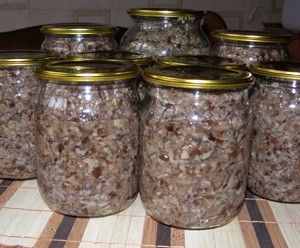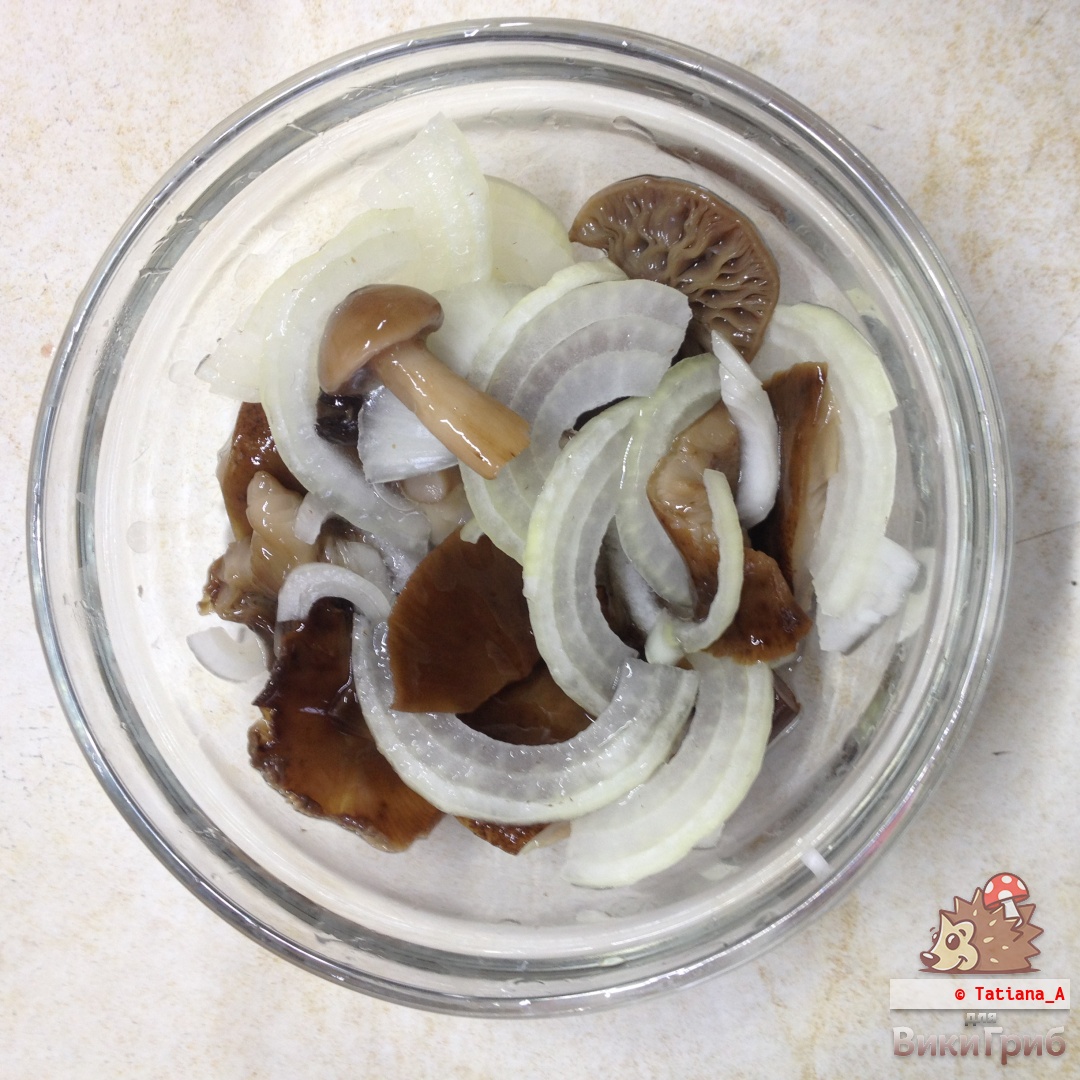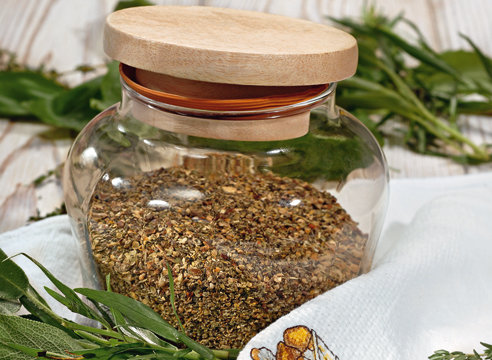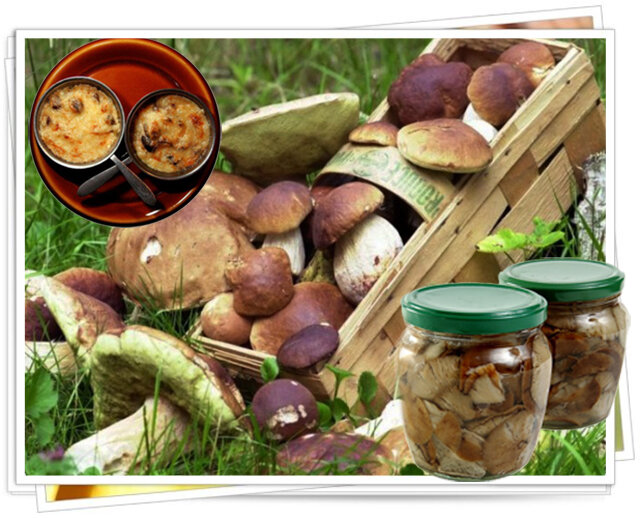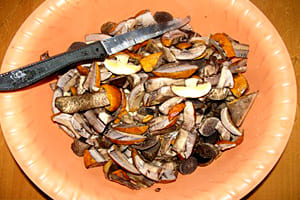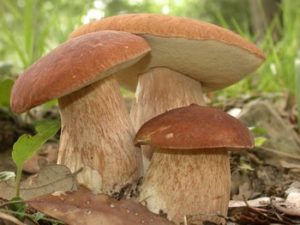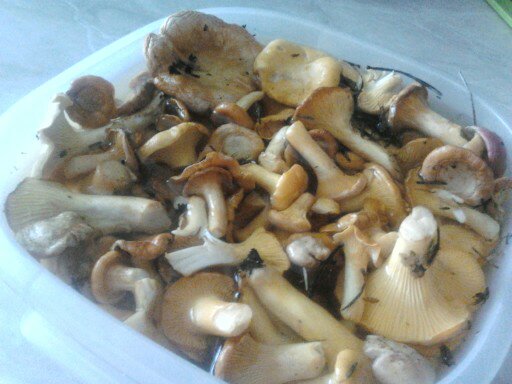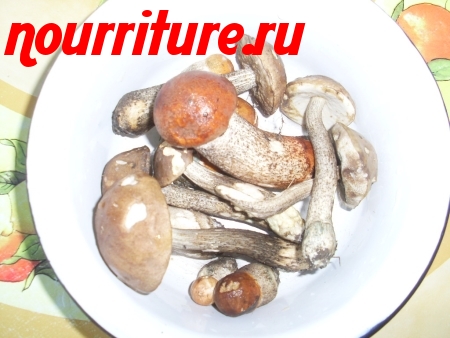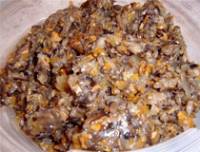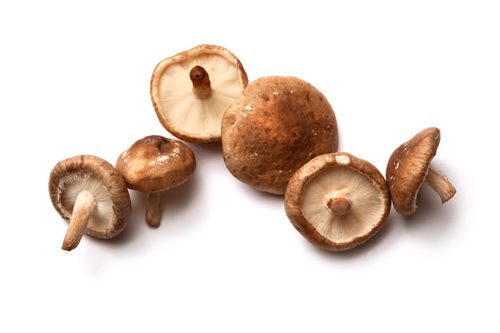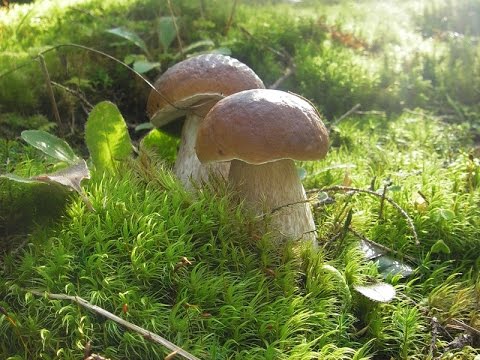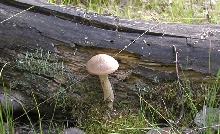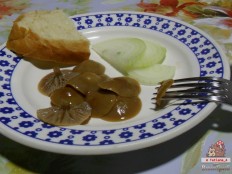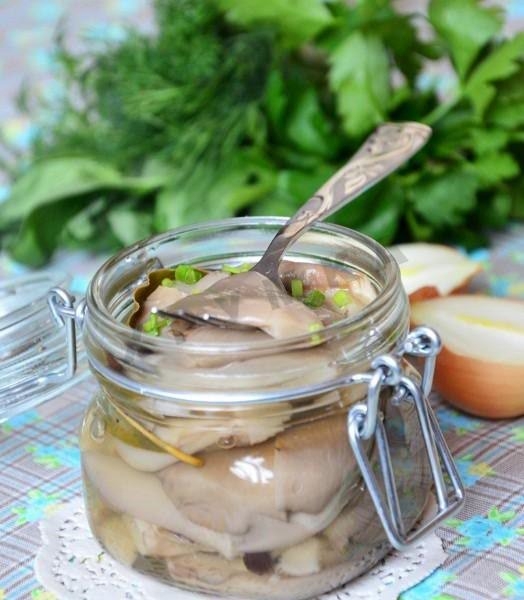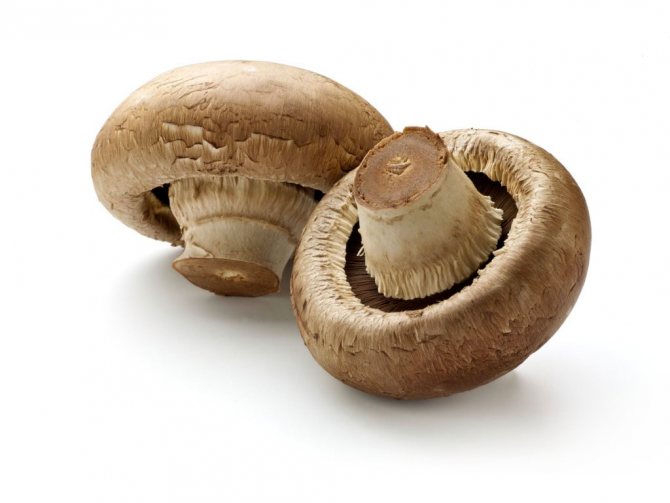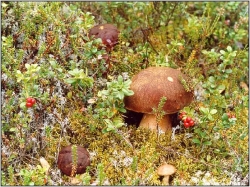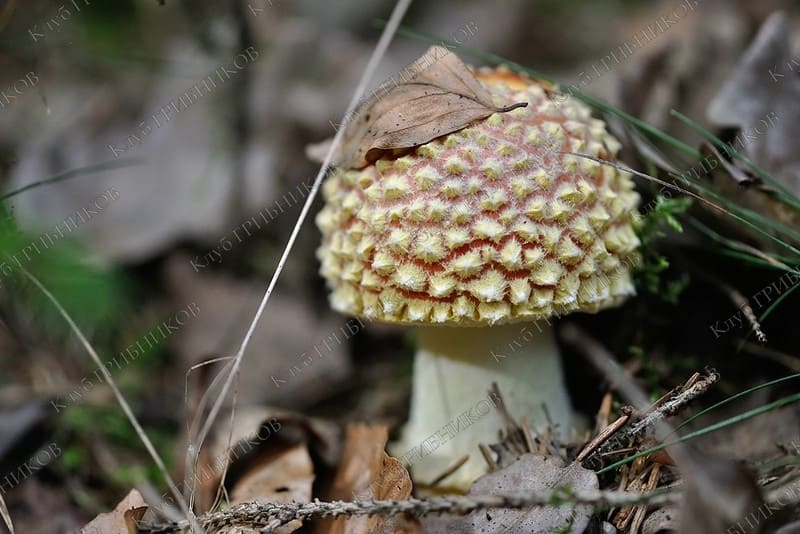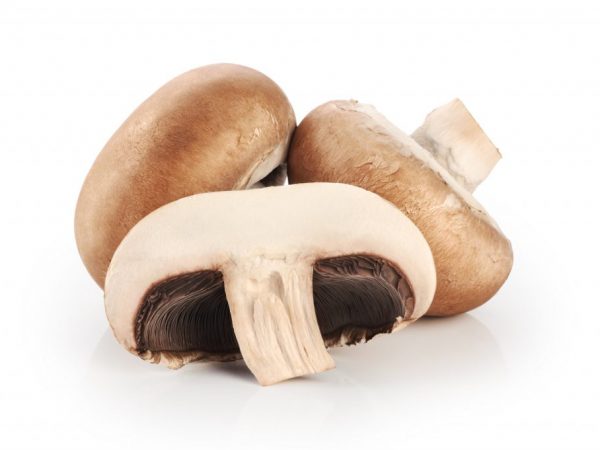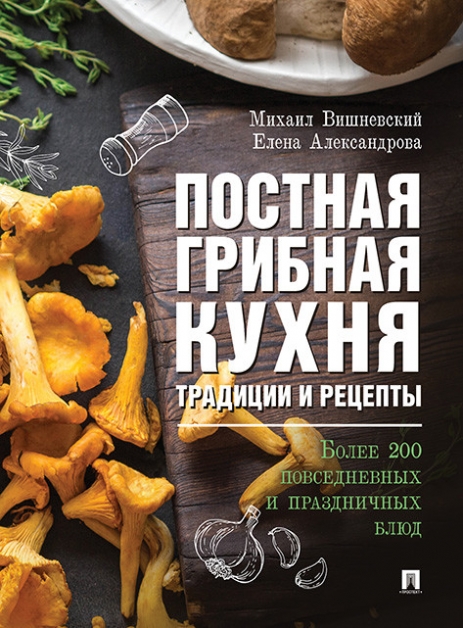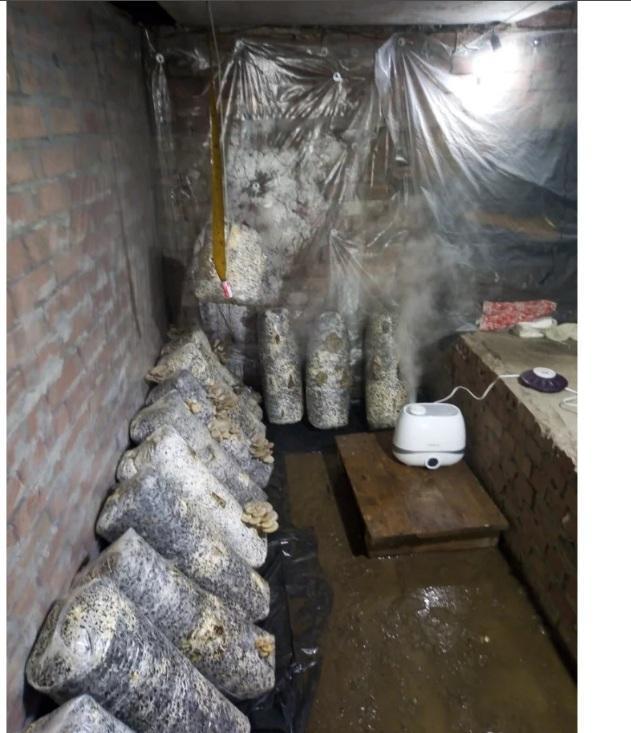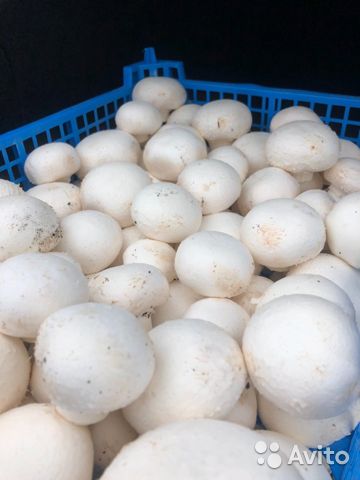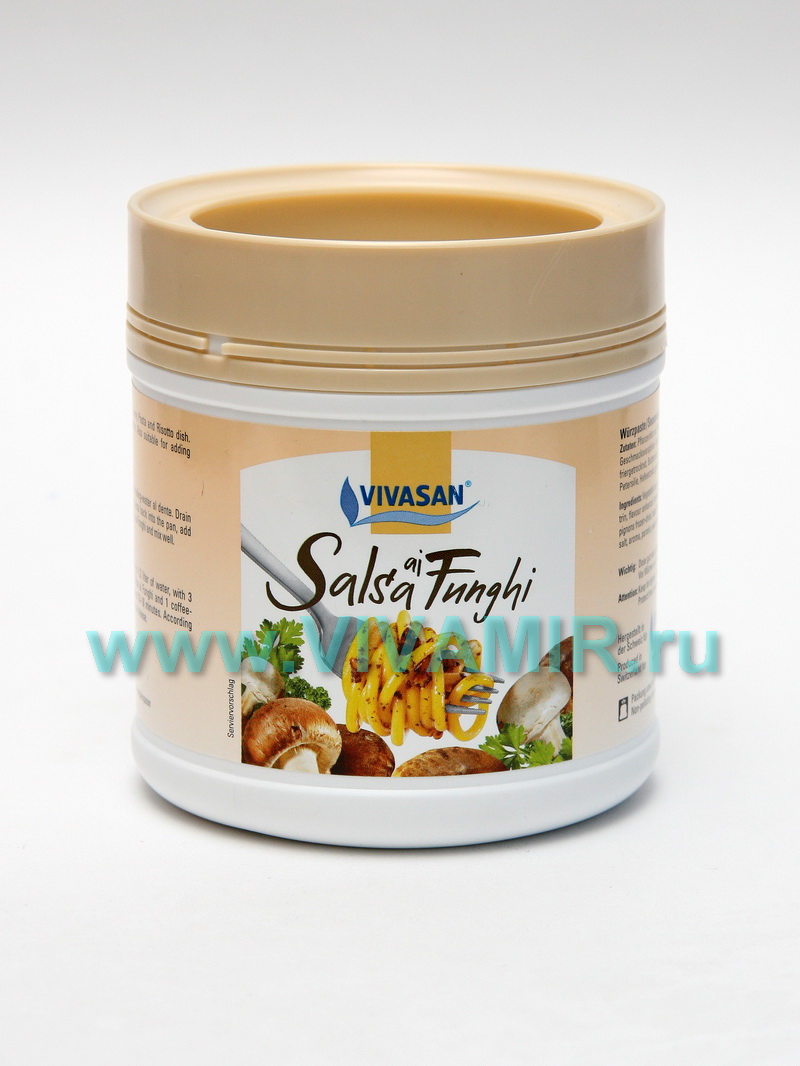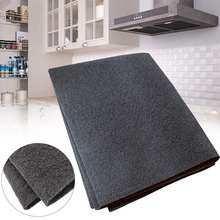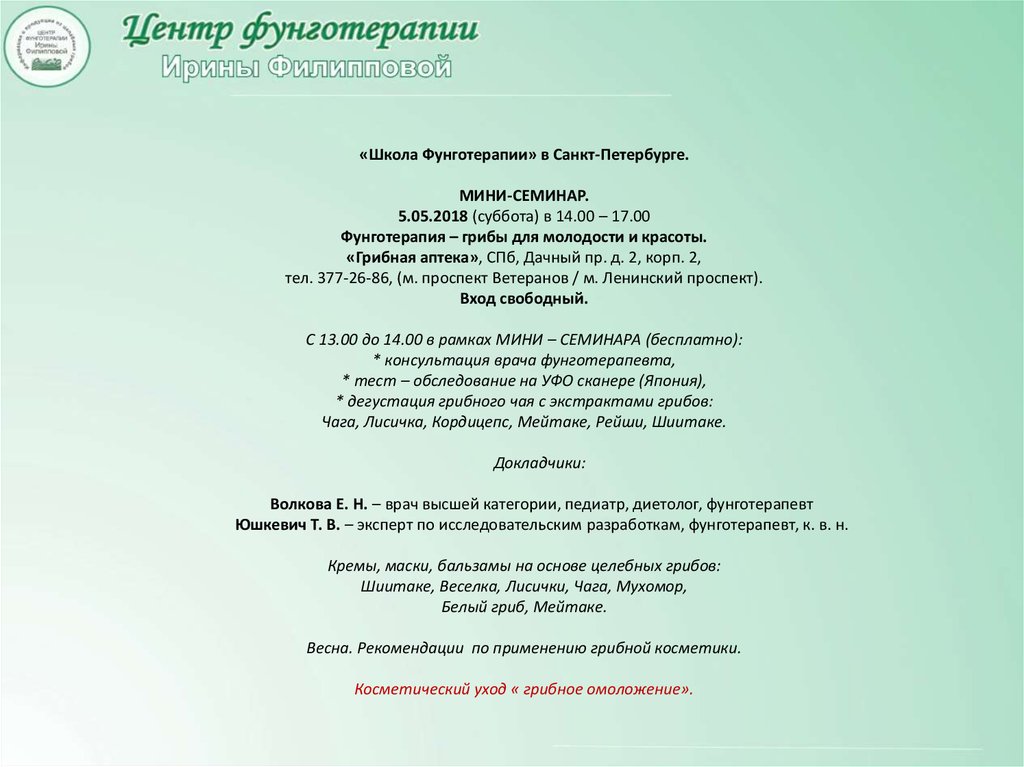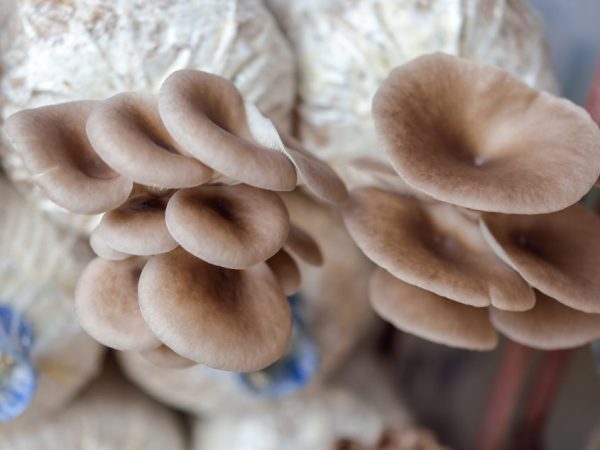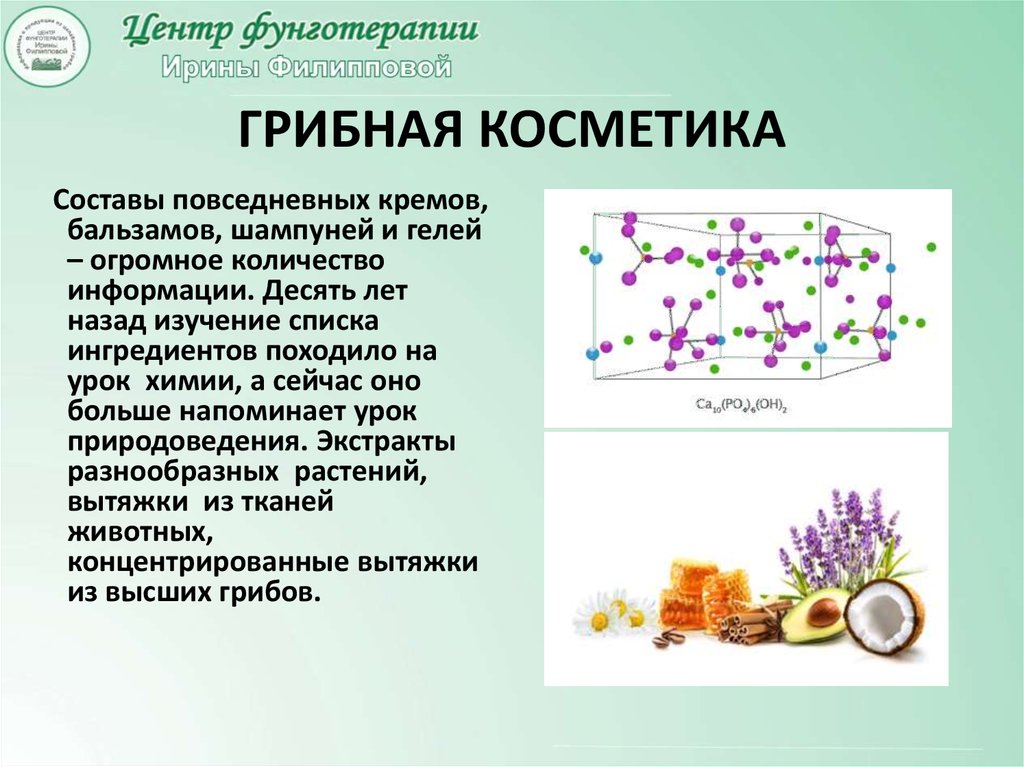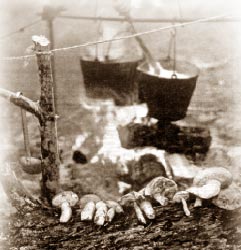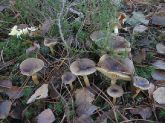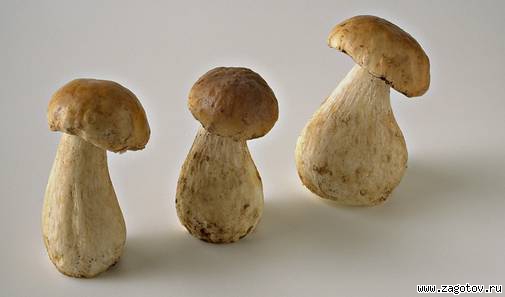Butterlets
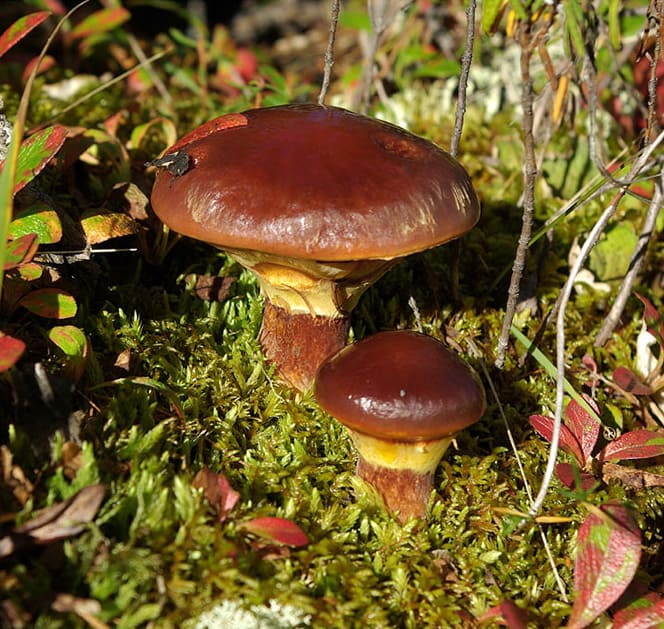
High quality edible mushrooms.
Mushrooms of this genus are common throughout the pine area in the northern hemisphere. Some types of boletus are found even in the tropics. 15 species are known only on the territory of the former Soviet Union.
The oil is characterized by a smooth, sticky or slightly slimy cap. Boletus with a fibrous cap is less common. Usually, the skin on the cap comes off well. A private blanket on the bottom of the cap, or is present, is absent, and if the cap is not sticky, then the blanket is always absent. The stem of the boletus is smooth or grainy, sometimes with a ring. The only drawback of this delicious mushroom is that it needs to be peeled, which can be very tiring after a long march.
Common oiler (late, real, yellow) - the most common among boletus. He has a slimy brown, dark brown, or chocolate bonnet. Less common are yellow-brown or brownish-olive caps. Well developed private bedspread, yellow tubules. The leg of this oiler is cylindrical, short, with a filmy ring. It bears fruit in July - September, often in large groups. Grows in pine forests, in lighted places, loves sandy soils. Distributed in the forests of Europe, the Urals, Siberia, the Far East, the Caucasus.
Fry, boil, marinate, salt and dry the late butter dish.
This mushroom bears a resemblance to the inedible pepper mushroom.
Larch oil can - grows in larch forests of Siberia, prefers young forests.
His cap is lemon yellow, yellowish orange or golden brown, sticky with an easily peeled skin. The size of the cap is from 4 to 13 cm. The tubules are yellow, later olive-yellow. The pulp turns slightly pink. Fruiting in July - September.
This butter dish is good for boiling and pickling.
Granular butter dish (summer, butter, yellow) - grows in the subzone of mixed and coniferous forests. Prefers pine forests, often grows in dry places, on roads, glades and in pits, rarely singly and mostly in groups from late May to early autumn.
His cap is mucous when dry, shiny, it can be from yellow-brown to brown-brown. The skin is easily removable. The lower surface of the cap of a young mushroom is light yellow in color, covered with a white film, which in an adult mushroom breaks off from the cap and remains at the stem in the form of a ring. The pulp is thick, dense, light yellow, yellow-brown, does not change color at the break, with a pleasant taste and fruity odor. The tubular layer is finely porous, thin, white, light yellow, then sulfur-yellow, with drops of milky-white liquid. The leg is short, up to 8 cm long, up to 2 cm in diameter, solid, cylindrical, light yellow, granular at the top.
Summer butters - high-yielding, tasty, edible mushrooms, are used without preliminary boiling for hot dishes, salting, pickling, drying. The summer oiler should be distinguished from the pepper fungus oilers belonging to the genus.
Harvesting
Reduce the humidity to 60% about 5 hours before harvest. This promotes the growth of tough skin on the surface of the mushroom cap and prolongs the shelf life of the product.
Do not wait until the shiitake is fully ripe, and their caps are covered with characteristic nets. Unripe mushrooms are much healthier.
Excess moisture reduces the quality of the mushrooms, stains the underside of the cap brown. Later, in these places the bacterial spot "settles". It is unlikely that anyone would want to buy such a product.
Cut off the fruit bodies with a knife or twist so that no fragments of the legs remain on the substrate. They can rot, provoke insect infestations or the development of mold.
Place the cut crop in a container, wrap it in plastic. So the harvest will last longer and will not dry out.
This is especially important if mushrooms are grown for sale and in large quantities.
Shiitake mushrooms have many beneficial and medicinal properties. And the Chinese emperors used the product to gain eternal youth and immortality.
But we are not talking about those shiitakes that are sold in our supermarkets. In pursuit of profit, farmers breed crops on sawdust, and this reduces its useful properties.
If you are interested in the healing properties of shiitake, try home cultivation using the extensive method. So you are guaranteed to get a useful product suitable for the preparation of infusions and extracts.
Flywheels

In fact, there are 18 species of mosshogs, common in temperate in temperate latitudes of both hemispheres. The most common are marsh flywheel, green flywheel and yellow-brown flywheel. They are all used boiled, fried, dried and pickled and salted.
The marsh moss with its structure resembles a boletus. Grows in mossy areas of coniferous forests. The cap and leg are yellow with a brown tint. The spongy layer is green or yellow-olive... The pulp is yellowish, turns blue on the cut.
Green moss is widespread in various forests of Europe, the Caucasus, the Urals, Siberia and the Far East. His cap is cushion-shaped, dry, velvety, grayish or olive-brownish. The tubules are yellowish-green with wide pores, sometimes descending to the peduncle. The stem is solid fibrous, yellowish or with a reddish tinge, with a brownish mesh, the intensity of which is expressed to varying degrees. The pulp is dense, white or with a yellowish tinge, does not change color or turns blue. Fruiting in June - October.
The flywheel is yellow-brown. It looks like a Polish mushroom. The cap is hemispherical to cushion-shaped, dry, velvety. In young mushrooms, it is grayish or dirty yellow, with age it becomes olive or reddish yellow. The skin is not removable. The pores are yellow, then with a greenish or olive tint, turn blue when pressed, then turn brown. The stem is cylindrical, solid, yellow or ocher-yellow, brown to the base with a reddish tint. The pulp is yellow; in the air it becomes bluish-green. Grows in moist pine forests, often among blueberries and mosses. Fruiting in July - October.
Cottage cheese paste for sandwiches, three options
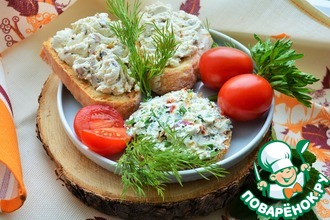
Category:
Appetizers Pates
It's hot in summer, and you don't really want hearty dishes, more often tea drinking and snacks are desirable. But, nevertheless, you need to eat, eat satisfyingly and with health benefits. I propose to cook several options for curd paste. Freshly prepared pasta must be cooled before use for a brighter flavor opening. On a piece of rye toast or on a baguette, this appetizer will not go unnoticed on the table, so it is advisable to have supplies in the refrigerator.
P. S .: I noticed that it is better to add dried vegetables or berries, they absorb excess curd whey, while softening themselves.
Where and how do they grow?
Edible woody mushrooms grow in the wild in Southeast Asia: Japan, China, Korea. Sometimes found in the Far East. In any other country, shiitake is grown only in artificial conditions.
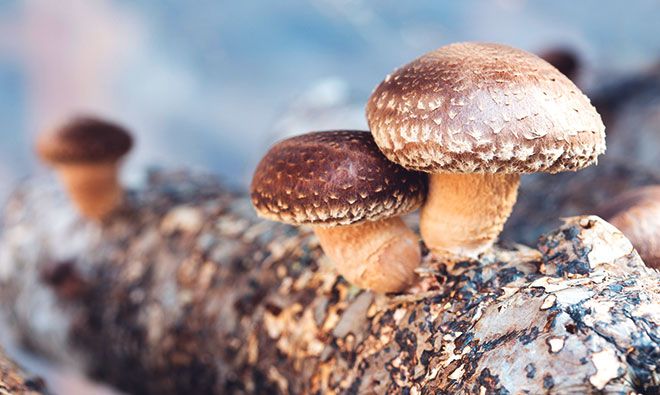
In Russia, climatic conditions are not the most favorable for shiitake, therefore, it is almost impossible to find them during a forest walk. The exception is the Primorsky Territory and the Far Eastern District, where mushrooms mainly grow on Mongolian oaks and Amur lindens. And also the culture develops on oak, mulberry, poplar, hornbeam, birch, chestnut, maple, beech, willow. Does not tolerate coniferous wood.
Having chosen a tree trunk or rotten stump, mushrooms germinate singly or in small groups. Having formed a symbiosis (mutually beneficial existence) with tree bark, Shiitake mushrooms do not lack nutrients.
In the natural environment, the crop is harvested during the off-season, after heavy rains have passed.In conditions of high humidity, the growth of mushrooms is accelerated and already 8 days after the appearance of the first shoots, you can harvest. Fruiting that begins in spring lasts until the first frost.
There are several ways to grow shiitake at home. The most popular is with the help of mycelium and sawdust (the technique has been used by mushroom growers since the 70s of the last century).
May mushroom

May Mushroom - Good quality edible mushrooms. He prefers humus soils in forests, on pastures, where there are thickets of bushes. It is found in many places, for example, in small forests, as well as in forests on humus and limestone soils. Doesn't favor any particular tree species. Often forms "witch rings". It first appears at the end of April, the peak of the season is in May, in June (depending on the weather) this mushroom disappears.
In the same places as the May mushroom, morels can be found in the spring.
The main distinguishing features of the May mushroom are that it grows in spring, the whole body of the mushroom is white, a strong flour smell.
The cap of the May mushroom reaches a diameter of 4–10 cm, convex, matte, dry, white or pale cream in color. The plates are white, narrow, frequent, notched. Spore powder is white. The leg is 3–8 cm high, 1–3 cm in diameter, white, matte, cylindrical in shape. The pulp is white, does not change color. The taste is soft, slightly mealy. The smell is strong, similar to the smell of wet flour.
May mushroom is eaten in different forms, except raw. It is especially tasty if fried properly (until golden brown) - then the flour taste disappears. It can also be dried and frozen.
It is unlikely that there are many mushrooms that appear in early spring with which the May mushroom can be confused. There is a resemblance to the poisonous entoloma (rosacea), also an early fungus, but it differs in a slender stem and not pure white color. If you cut off the cap from the entoloma and put it on a sheet of white paper for a couple of hours, covered with a glass, you can get a spore powder that turns out to be reddish, and not white, like that of the May mushroom.
Composition and nutritional value
If we talk about calorie content, then it depends on the chosen cooking method. If the mushrooms are fresh, the energy value is small - only 17 calories per 100 grams. But they are not eaten raw, because the calorie values are usually higher. For a pickled product, it is relatively small - only 22 kcal per 100 grams. Therefore, honey mushroom is an excellent option for a losing weight diet.
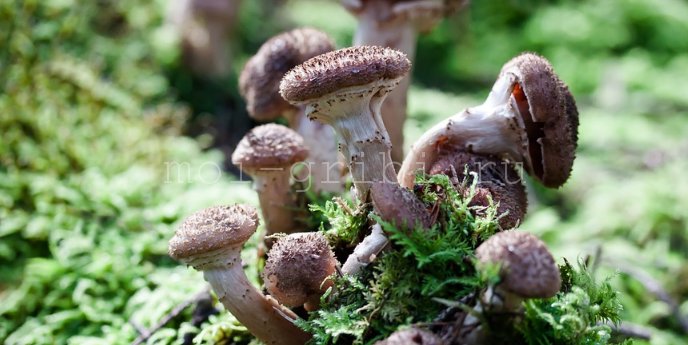
Fresh mushrooms provide the body with a large amount of vitamins and protein. They are low in calories, so they are often included in vegetarian or diet menus. If, after collecting, the mushrooms are subjected to a short heat treatment (for example, boiled), their benefits will remain in full. It is related to the composition of the product:
- Vitamin B3. He takes an active part in metabolic processes - fats, carbohydrates, proteins, participates in the formation of blood cells, improves the secretion of gastric and bile juice. This substance helps to stabilize blood flow, vasodilation, reduce blood pressure, and normalize cholesterol levels. It helps prevent thrombosis and maintains excellent skin condition. Vitamin has a positive effect on the digestive tract, brain, nervous system.
- Vitamin B2 (riboflavin). It is necessary for the absorption of iron, tissue repair, ensuring an excellent state of the nervous, reproductive system, heart. Riboflavin promotes the assimilation of protein, the conversion of sugar into energy, improvement of vision, color perception. This substance enhances the effect of other equally useful vitamins. If there is enough of it in the body, skin, nails and hair look healthy.
- Vitamin C. It is a beneficial antioxidant. It helps to preserve the integrity of tissues, strengthen blood vessels, improve the condition of the skin, and rapid healing of wounds.Takes an active part in neutralizing toxins, strengthening the body's defenses, normalizing sleep, improving the condition of teeth and gums.
- Magnesium, potassium are necessary for the normal functioning of the cardiovascular system, maintaining the elasticity of blood vessels and preventing thrombosis by thinning the blood. A person who is deficient in these substances complains of arrhythmias and pain in the heart.
- Iron. It is necessary for those who suffer from anemia. It forms hemoglobin, delivers nutrients to the organs. Thanks to him, the thyroid gland produces hormones, and the body temperature remains stable.
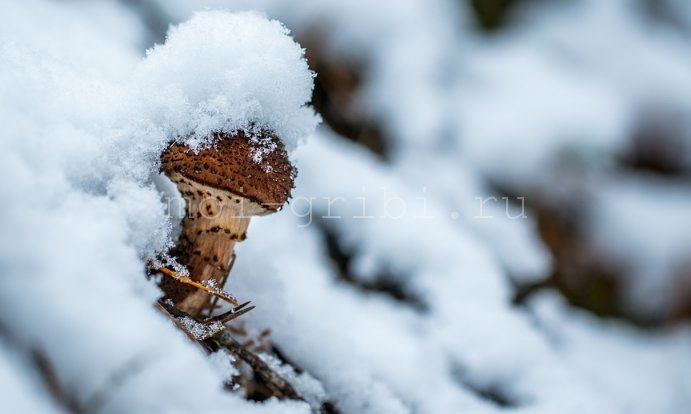
Mushrooms are often prescribed for prolonged constipation as a laxative. But they can cause diarrhea in people with a weak gastrointestinal tract.
Honey mushrooms, like lichens, algae, are a source of beta-glucan or medicinal sugar. They are used for the prevention of cancer, hypertension, diabetes, atherosclerosis. In medicine, their use is associated with the treatment of staphylococcus and Escherichia coli.
Protein bread for diabetics is made from the autumn variety. For the Austrians, it is a natural laxative. Chinese scientists have proven that mushroom extract prevents the development of malignant tumors.

Shiitake mushrooms: what are they?
Shiitake mushrooms (other names - "Chinese mushrooms", "imperial mushrooms", "elixir of life") are the world's most grown edible tree mushrooms of the genus Lentinula, which are native to China. In Japan, China and some Asian countries, they can be found in the wild. In other countries, these mushrooms are grown in artificial conditions. There are several ways to grow shiitake, the most popular of which is growing with pressed sawdust mixed with mycelium. This method of cultivation began to be actively used since the 70s of the last century, when the demand for shiitake skyrocketed.
Mushrooms grown in artificial conditions, which can be purchased in our supermarkets, have excellent taste, but contain very few nutrients in their composition. Only shiitake grown naturally or on wooden decks have medicinal properties. Extracts of just such mushrooms are suitable for the manufacture of dietary supplements (biologically active additives) or drugs.
Shiitake mushroom has a dense, fleshy texture, and in appearance resembles a regular champignon, but with a richer brown color. Its lamellar cap is covered with cracks and small scales. The average diameter of the cap is 13 - 18 cm. Some shiitake mushrooms have a fringe, which is a protective membrane that ruptures after the pores have matured. The average weight of one mushroom is 85 - 105 g.
These mushrooms are sold canned, fresh, dried or in powder form.
Gall mushroom (false white)
Occurs quite often throughout the territory THE USSR. Grows in coniferous forests mainly on sandy soils, occasionally on rotten stumps or on the base of trunks, singly and in groups, in July - October. The cap of a young mushroom is hemispherical, later cushion-shaped, brownish or brown with a gray or yellow tint. The tubular layer is finely porous, pale or dirty pink. The leg is tuberous at first, then stretches, the same color as the cap, but lighter, with a mesh pattern. The pulp is strong, white, bitter. At a young age, the gall fungus is very similar to the white one. The main differences are: a dark mesh pattern on the leg (in a porcini mushroom it is white), a dirty pinkish bottom of the cap (in a porcini mushroom, the tubular layer is always white or cream, turns yellow or green with age), bitter flesh (it is enough to lick the bottom of the cap to feel bitterness) - that's why the gall mushroom is also called bitterness. At the break, the flesh turns pink (in boletus it is always white). The mushroom is poisonous.
Premises
For growing oyster mushrooms, you can use both underground and aboveground premises. Garages, hangars or basements are perfect.Among the main requirements for a place, a special place is occupied by:
- good illumination,
- the presence of an optimal temperature regime,
- good ventilation.
If the cultivation takes place in large rooms, then it is better to divide them into small ones, which will increase the volume of mushroom production.
The room temperature depends on the growth stage of the mushrooms. During the incubation period, the temperature should be at least 20 ° C, during fruiting, it is advisable to observe the regime of 15-20 ° C. During the incubation period, the room is sometimes not ventilated.
It is necessary at all stages of production:
Dirty area (substrate workshop)
When manufacturing a substrate using any of the technologies, a lot of steam is released - therefore, it is advisable to have a hood in the workshop.
If the production is small, and the hydrothermal is done in a 200-liter barrel, this can, of course, be neglected. But the larger the substrate area in terms of productivity, the more important the topic of steam removal becomes.
Clean area (inoculation or seed)
The ventilation system consists of:
- blowing supply fan,
- coarse and fine filters,
- heat exchanger for heating in winter,
- duct inside the seed room itself.
The exhaust fan is not placed in the clean area, and the supply fan is calculated so that there is a slight overpressure (in the room of the cleanest area - 60 Pa, in adjacent rooms - 50-40 Pa).
This air duct made of polyethylene film is placed either near the doors of the container where the substrate is located (for xerothermia and pasteurization), or above the seeding table (for hydrothermal treatment).
A large number of small holes are made in the duct with a soldering iron.
If the seeding room is small, a household axial fan for the kitchen can be placed in the window opening (window), which works for injection. And make a hole in the other wall - to squeeze out excess air.
Since filtration in the inoculation room is mandatory, the filter must also be installed in this case.
Before the start of sowing, the clean area is treated with disinfectants, then the ventilation is turned on and, due to a small excess pressure, the outside untreated air is not sucked into the sowing room.
On the contrary, air is forced through all the slots and passes through the filters. This prevents mold spores from entering the treated substrate.
Incubator
The main task of ventilation is timely heat removal from overgrown mushroom blocks. Incubation mainly uses recirculated air. On the 5-6th day of the incubation period (at the peak of heating), to maintain the optimum temperature in the center of the block (30-32 degrees), fresh air is gradually added to the recirculated air - about 10-15%. If this is not enough, turn on the air conditioner. A large amount of fresh air is not used when the blocks are overgrown.
Direct preparation of the substrate
It doesn't matter what you use as a substrate. The most important thing is to prepare it correctly.
For intensive growth of mushrooms, special additives can be added. A substrate for shiitake is being prepared according to the classical scheme, but here you should take into account the nuances.
Use of sawdust
- On pasteurized sawdust, the yield of shiitake is lower than on sterilized;
- The optimum temperature for sterilization is 120–130 C °, duration - no more than 3 hours;
- If the processing time is exceeded, the quality of the substrate will decrease, and decay products harmful to the mycelium will appear in the sawdust;
- Shiitake substrate is first packed and then processed;
- Sawdust with a size of 3 mm is suitable for growing shiitake.
It is not easy to process sawdust at home, so many mushroom growers tend to favor straw.
Using straw
- Grind the straw to a three-centimeter section, fill it with hot water and leave for 12 hours, maintaining the water temperature at 60 ° C.
- Place on a cooking rack to cool.
- Fill the bags with wet mixture and repopulate the mycelium.
- Check for moisture by squeezing the substrate in your hand (no water should come out of it).
Do not grow shiitake on rice hulls. A scarce substrate will "drown" the potential of the crop and the resulting crop will not have useful properties.
Nutritional value of shiitake mushrooms
Highly digestible, low-calorie shiitake is rich in fiber, useful minerals and B vitamins. They do not contain cholesterol, trans fats and other components harmful to the body. And the ratio of BZHU can be called ideal.
100 g of fresh mushrooms contains:
- 14.4 grams of carbohydrates equals nearly 88% of all energy per serving
- 1.56 g protein;
- 0.22 g fat;
- 83.48 g water;
- 0.35 g of ash.
There are only 34 Kcal per 100 grams of fresh mushrooms.
Composition and useful properties
Shiitake mushroom is an expensive pleasure, because for many countries it is exotic. And yet, the high cost does not in any way affect the selling out of the product.
People are not stingy because regular consumption of Chinese mushroom has a positive effect on health. And the therapeutic effect of the product on a person is due to its unique composition:
| B vitamins | They normalize the functioning of the nervous, digestive and cardiovascular systems, improve the psycho-emotional state, strengthen the immune system, prolong youth, and protect against the development of oncological neoplasms. |
| Vitamin D and D2 | Improves the condition of the skin, increases the absorption of calcium, which is necessary for the health of bones and teeth. |
| Vitamin C | Strengthens blood vessels, ensures full cell growth, prolongs youth, slows down the development of cancer cells, increases the protective properties of the body, etc. |
| Copper | Normalizes blood composition, has antimicrobial and anti-inflammatory properties, participates in the production of collagen, elastin, etc. |
| Selenium | Participates in metabolic processes, maintains the functionality of the thyroid gland, protects cells from damage, reduces the risk of developing cancer and Alzheimer's disease, and reduces asthma symptoms. |
| Manganese | Supports the state of the reproductive system, participates in the processes of hematopoiesis. |
| Zinc | Accelerates wound healing, normalizes hormonal levels, increases the resistance of the immune system, and improves the functioning of the digestive tract. |
| Calcium | Prevents softening, fragility of bones, normalizes metabolism, reduces manifestations of allergic reactions, removes salts of heavy metals and radionuclides from the body, lowers blood pressure, and normalizes sleep. |
| Iron | Supports the functioning of the respiratory system, saturates the blood with oxygen, launches regenerative processes in tissues, and ensures a normal concentration of hemoglobin in the blood. |
| Phosphorus | It normalizes metabolism, increases the absorption of nutrients, vitamins, supports kidney function, cleanses from toxins, improves brain activity, and keeps the body in good shape. |
| Magnesium | Participates in the formation of proteins (building material of tissues and organs), increases stress resistance, soothes seizures, increases efficiency, and normalizes sleep. |
| Potassium | Supports the water-salt balance paired with sodium, the functioning of the nervous system and heart, provides muscle tone and high performance, improves well-being. |
| Sodium | Stimulates the production of gastric juice, activates the production of insulin, activates the activity of the nervous and muscular systems. |
Thanks to its medicinal properties and amazing taste, the Chinese mushroom is a welcome product in any kitchen. Those who regularly consume the product or take it as a supplement report the following effects:
- Blood pressure stabilizes.
- The heart rate is leveled.
- Shortness of breath goes away.
- Puffiness subsides.
- Excess weight goes away.
- Reduces blood sugar.
- Working capacity increases (physical and intellectual).
- The psychoemotional state is stabilized (people endure stressful situations more easily).
- An unprecedented surge of energy is felt.
- The work of the digestive system is normalized, intestinal motility improves.
- The hormonal background is stabilized.
This list can be continued indefinitely, because the beneficial properties of shiitake affect all parts of the body, normalizing a person's well-being.
Christmas pelengas princess
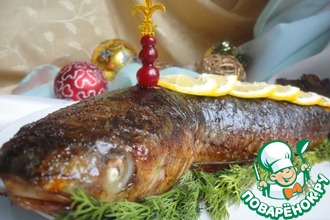
Category:
Hot dishes Fish and seafood dishes Stuffed fish and seafood
In the evening before Christmas in Ukraine, it is customary to set a table of 12 lenten dishes. We call him Svyatvechir. Obligatory dishes are kutia and uzvar. I published my version of these dishes a year ago (I will even give a link to the recipe below). Also, as a rule, there are lean dumplings on the table, and for the "main hot" I usually either bake whole fish or cook fish cakes (my homemade baluvani and fish are eaten either without bones or in the form of cutlets). This year, such a dish was the baked pelengas. Help yourself!
Ingredients for Mushroom Extract:
-
Mushrooms
—
1 kg -
Water
—
2 l -
Salt
—
1 tsp
Cooking time: 60 minutes
Mushroom extract recipe:
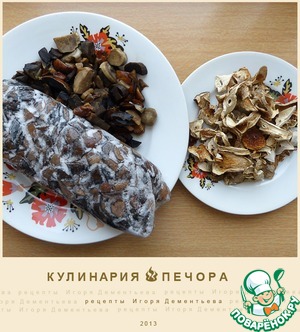
Spring. Many blanks are coming to an end or already require disposal, as the storage periods are already coming to an end. This primarily applies to freshly frozen mushrooms, the shelf life of which under certain conditions ("two stars") is limited to six months and nine with "three stars". You can boil the mushrooms and roll them up in jars, or you can make an amazing seasoning out of it - mushroom extract. All types of tubular mushrooms are suitable for it, and of the lamellar ones, only late hygrophors, mushrooms or russula are edible.
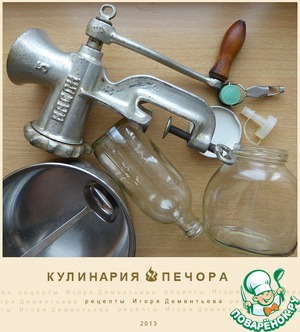
Items
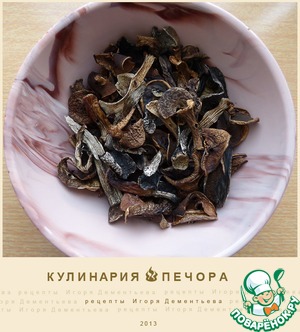
Also, of course, you can make an extract from fresh or dried mushrooms. But even to fresh ones, to enhance the aroma, I advise you to add a small amount of dried mushrooms (after soaking in water, and use the infusion when cooking), especially if you have in stock white and especially fragrant "black mushrooms" - mushrooms, boletus and boletus mushrooms.
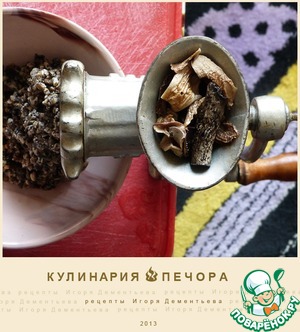
So, roll the mushrooms (fresh, thawed, dry-swollen) in a meat grinder once or until the state of "caviar" in a blender.
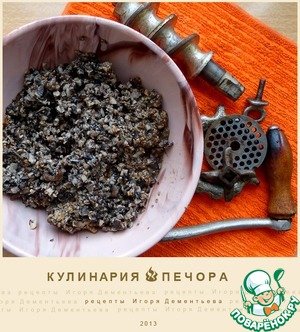
The resulting "caviar"
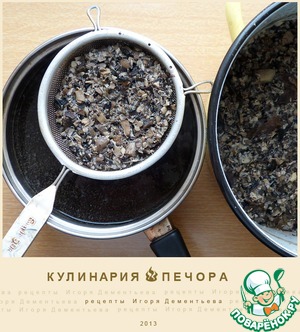
Place in a saucepan and boil in its own juice for thirty minutes and stirring so that the mushrooms do not burn. Strain through a fine mesh into a clean dish.
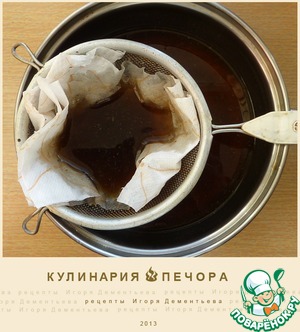
Pour the strained mushrooms again with a little water and boil again over low heat for thirty minutes.
Strain again through napkins to the first broth.
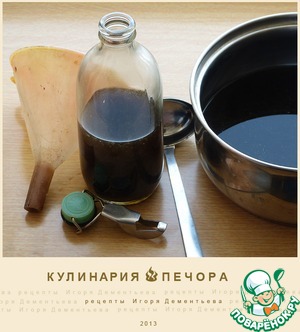
(Boiled mushrooms can be used in any dish, including as mushroom caviar or a base for mushroom oil, or simply thrown away (do not give to pets!).
Add a teaspoon of salt per liter of broth, boil until viscous and pour into containers in which the extract will be stored.

For short-term storage (no more than one month or two) in the refrigerator, any bottles with lids, corks or jars are suitable. Aromatic oil can be poured on top of the extract, this will increase the shelf life.
For longer storage, pour the extract into sterilized jars and process in a known manner. The shelf life of pure pasteurized extracts is up to 3 years.
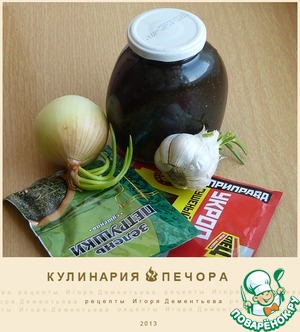
Also, when preserving, you can add flavoring and flavoring components. For example, boil in the second part of cooking along with finely chopped spices and herbs, onions and garlic, but in this case it is better to add acids and sugars. For example, vinegar and white sugar. Shelf life up to 5 years, in the absence of impurities, of course (parts of herbs, roots, mushrooms, etc.).
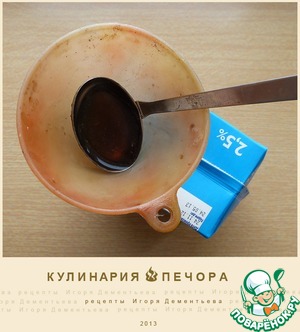
Store outside the refrigerator in a cool, dark place.
Use for the preparation of broths (just diluted with water), for sauces, fumé, aspic, etc.
Or just pour over the boiled potatoes!
It can also be stored frozen: pour the cooled extract into milk or juice containers that have lids.
Place in the freezer. Shelf life with "three stars" is six to nine months.
Potential harm
Honey mushrooms, the benefits and harms of which are constantly discussed, should be eaten carefully. Too frequent use threatens with problems with the pancreas or even poisoning with toxins
False varieties are very harmful to a weak stomach, causing diarrhea.
Who is undesirable to use
For some categories of people, it is desirable to permanently or temporarily stop eating mushrooms. You shouldn't use them:
- pregnant women, during lactation;
- patients with gastrointestinal ailments;
- children 7-10 years old, up to 13 years old, small portions are possible;
- allergy sufferers, with individual intolerance;
- hypertensive patients, heart patients.
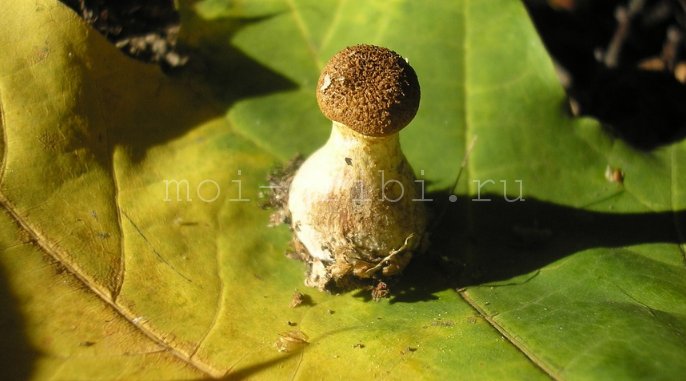
You can seriously harm your health if:
- eat mushrooms raw;
- eat a lot of such a product with a weak stomach;
- confuse a false species with a real one.
The inedible type is easily recognized by the color of the cap - there are bright spots on it. In real mushrooms, the plates are white, in false ones they differ in color - purple, pink, yellow, brown.
Did you like our article? Share with us interesting recipes for cooking honey agarics.
What is important to know about Shiitake mycelium
Shiitake mycelium is sold in liquid and dry form. Dry is grain and sawdust (grown on sawdust). It can be bought at any large mushroom farm. Application rates:
| Grain mycelium | 2-5% by weight of the substrate |
| Sawdust mycelium | up to 7% |
| Liquid mycelium | about 60% |
Buy mycelium from reputable suppliers or directly from mushroom farms.
Sow with mycelium in a greenhouse in a sterile, dust-free room and sterile basin. Treat the spoon and container with chlorhexidine and start preparing the seed. To grow healing shiitake in natural conditions, order sticks with mycelium.


